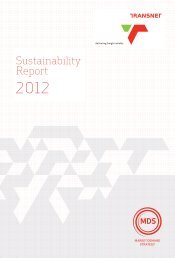Basic Assessment Report - Transnet
Basic Assessment Report - Transnet
Basic Assessment Report - Transnet
Create successful ePaper yourself
Turn your PDF publications into a flip-book with our unique Google optimized e-Paper software.
<strong>Transnet</strong> LimitedProposed RO Plant: Port of SaldanhaFinal <strong>Basic</strong> <strong>Assessment</strong> <strong>Report</strong>7.4.3 Alternative Options for Disposal of Brine by-productThe following alternatives to discharging the brine back into the Bay have beenidentified and considered by the project team. These primarily consider options fordisposing of the brine by-product via land based alternatives:• Evaporation PondsThe use of evaporation ponds for disposal of brine would allow for the water toevaporate from the brine, leaving salt, which could potentially be harvested. In orderto deal with the volume of brine resulting from the RO plant (estimated at4 400m³/day) initial calculations have indicated that an area of land approximately2km by 2km in size will be required for the location of an evaporation pond of asuitable size. Additional infrastructure associated with the transfer of brine to theevaporation ponds would include pipelines, linings for ponds, pumps, roads, power,earth works, and buildings.The use of sprinklers to assist with evaporation may help to reduce this sizerequirement; however this would increase operational costs, require additional waterand would need to be managed very carefully (e.g. to eliminate the potential effect ofbrine spray on adjoining properties during windy conditions). The volumes of saltgenerated would require some form of disposal or a buyer would need to be found.This option is likely to have a higher (negative) impact on the groundwater in the areashould the brine leak through the evaporation pond into the groundwater table. Inaddition, there is insufficient land area in close proximity to the iron ore handlingfacility that can be used to locate the evaporation ponds, and additional land wouldneed to be purchased, which is likely to make this alternative very costly. If land wereto be purchased it is likely that it would need to be rezoned for the purposes of anevaporator pond resulting in timeframes which are not aligned with the immediateneed. Therefore, this option was not considered either reasonable or viable and waseliminated from the alternatives to be assessed in the BA process.• Piping brine to SaltworksThe possibility of pumping brine to an existing saltworks in the area (e.g. Veldrif,Cerebos), thus allowing for the beneficial use of the brine was identified as an option.This would require agreement with a registered saltworks, as well as confirmation ofsufficient capacity within the salt works to deal with the volumes of brine that wouldbe produced.It was assumed for this option that the RO Plant would be situated inside the port andthe intake would be via intake wells. The discharge pipeline route would follow localroads in the area to avoid disruption to residential infrastructure as far as possibleand to discharge the brine at (either) the Velddrif or Cerebos Salt Works. Amunicipal servitude may also be available for the laying of the pipeline in thisalternative but would be subject to an agreement being reached between <strong>Transnet</strong>35Prepared by the PDNA/SRK Joint Venture
















